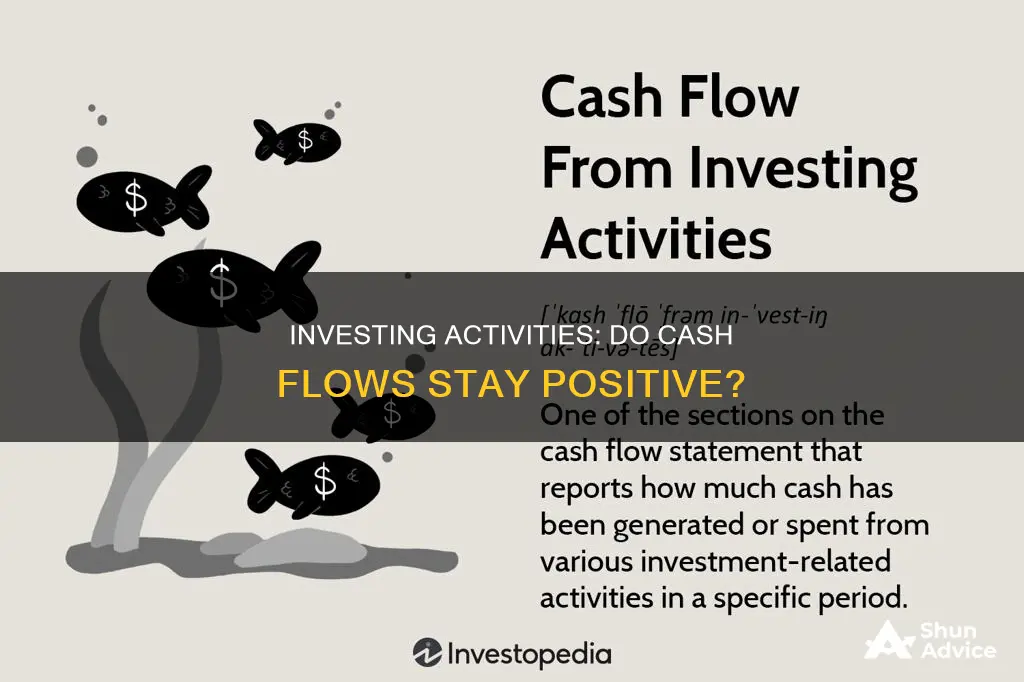
Cash flow is the movement of money into and out of a company over a certain period of time. A company's cash flow statement is one of the three main financial statements that a business uses and it shows how much cash is generated or spent on operating, investing, and financing activities for a specific period. Cash flow from investing activities (CFI) is one of the sections of a company's cash flow statement. It reports how much cash has been generated or spent from various investment-related activities in a specific period. This includes the purchase or sale of non-current assets, investments in securities, or the sale of securities or assets. Cash flow from investing activities can be negative or positive. Negative cash flow from investing activities is not always a warning sign. It could indicate that management is investing in the long-term health of the company, such as research and development. Positive cash flow indicates that a company's liquid assets are increasing, enabling it to cover obligations, reinvest in its business, and return money to shareholders.
| Characteristics | Values |
|---|---|
| Definition | Cash flow from investing activities refers to the amount of cash that has been generated or spent on various investment-related business activities. |
| Importance | It is a key indicator of a company's financial health and future prospects. |
| Types | Cash flow from investing activities can be positive (cash generated by sales of investment securities or assets) or negative (cash spent on long-term assets, lending, or marketable securities). |
| Interpretation | Negative cash flow from investing activities is not always a warning sign. It could indicate that management is investing in the long-term health and future growth of the company. |
| Examples | Purchase of property, plant, and equipment; sale of assets; investment in marketable securities; acquisition of businesses; lending money; collecting loans. |
What You'll Learn

Cash Flow from Investing Activities (CFI)
Investing activities include the purchase and sale of non-current assets (or long-term assets) and marketable securities. Non-current assets are expected to deliver value in the long run (over one year) and are highly illiquid, meaning they cannot be easily or quickly converted to cash. Marketable securities, on the other hand, are more liquid and can be converted to cash more readily.
CFI can be calculated using the following formula:
> Cash flow from investing activities = CapEx/purchase of non-current assets + marketable securities + business acquisitions - divestitures.
Here, divestitures refer to the sale of investments.
CFI is important because it provides a clear breakdown of how much a company has spent on future growth and how consistently investments are being made. It also allows for the identification of cash held in marketable securities, which can be used to free up cash when needed.
It is important to note that negative cash flow from investing activities does not always indicate poor financial health. It may instead reflect a company's investment in long-term assets and future growth strategies.
Cash Investments: What Are They?
You may want to see also

Long-term assets
When a company invests in long-term assets, it is reflected in the cash flow statement as a negative cash flow from investing activities. This is because the purchase of long-term assets involves cash outflow. However, it is important to note that negative cash flow from investing in long-term assets is not necessarily a bad sign. It often indicates that the company is making strategic investments in its future operations and efficiency, which may lead to increased capacity and improved long-term results.
On the other hand, the sale of long-term assets results in a positive cash flow from investing activities. This involves cash inflow, as the company receives money from selling its assets. This can be a sign of the company's flexibility and skill in managing its assets effectively.
The cash flow statement is an essential tool for investors and analysts to understand a company's financial health and growth prospects. It is one of the three main financial statements, along with the balance sheet and the income statement. By analyzing the cash flow statement, stakeholders can assess the company's investment strategies, financial standing, and future potential.
In summary, long-term assets play a crucial role in a company's investing activities, and their purchase or sale has a direct impact on the cash flow from investing activities. It is important to consider this context when interpreting the cash flow statement to gain an accurate understanding of the company's financial health and strategic direction.
Cash Investment Strategies: Your Guide to Profitable Opportunities
You may want to see also

Negative cash flow
However, negative cash flow from investing activities could also be a warning sign that a company's management is not efficiently using its assets to generate revenue. It could indicate that the company is facing declining demand or becoming obsolete. Therefore, it is important to review the entire cash flow statement and analyse the context and industry to determine the implications of negative cash flow from investing activities.
A consistent negative investing cash flow can be a healthy sign of a growing company, but if there is no subsequent increase in cash flow from operating activities, it could indicate overcapitalisation and lead to a cash flow bottleneck. Additionally, a drop in fixed-asset investment or a consistent reduction in investments in fixed assets could signal a lack of profitability or available funding.
Best Places to Invest Your Cash Today
You may want to see also

Positive cash flow
A company's cash flow statement will show how much cash has been generated from investment-related activities in a specific period. This will include the purchase or sale of non-current assets, such as property, plant, and equipment (PPE), and marketable securities, such as stocks and bonds.
It's important to note that positive cash flow from investing activities does not always indicate strong financial health. It could also mean that a company is selling off assets because it doesn't have the cash to make further investments. Therefore, it's crucial to analyse the entire cash flow statement and all its components to determine the financial health of a company.
Extra Cash: Where to Invest for Maximum Returns
You may want to see also

Cash flow statement
The cash flow statement is one of the three primary financial statements that a business uses, alongside the balance sheet and income statement. It provides an overview of the cash generated or spent on operating, investing, and financing activities over a specific period.
Cash Flow from Investing Activities
Cash flow from investing activities (CFI) is one of the three sections of a company's cash flow statement, alongside cash flow from operations and cash flow from financing activities. CFI tracks the net amount of cash generated or lost from investing activities over a specific period, known as the accounting period.
CFI includes a range of investing activities that involve the cash purchases and disposals (selling) of non-current assets. Non-current assets, or long-term assets, are expected to deliver value and benefits in the long run (over a year) and are highly illiquid, meaning they can't be easily or quickly converted to cash.
- Purchase of property, plant, and equipment (PP&E) or capital expenditure (CapEx) - cash outflow
- Selling off or leasing PP&E - cash inflow
- Investment in marketable securities such as stocks and bonds - cash outflow
- Selling off marketable securities - cash inflow
- Acquisition of businesses and companies - cash outflow
- Selling off businesses and companies - cash inflow
- Lending money - cash outflow
- Collecting loans - cash inflow
Calculating CFI
There is no singular agreed-upon formula for calculating CFI, but the following formula is generally accepted:
> Cash flow from investing activities = CapEx/purchase of non-current assets + marketable securities + business acquisitions - divestitures.
> *Divestitures = the sale of investments
CFI and Company Growth
Negative cash flow from investing activities does not always indicate poor financial health. It often means that a company is investing in long-term assets or other growth initiatives. For example, a company may invest in fixed assets such as property, plant, and equipment to grow its business, which will result in negative cash flow from investing activities in the short term but may generate cash flow in the long term.
A consistent negative investing cash flow can be a sign of a growing company that may provide positive returns in the future. However, a sudden drop in fixed-asset investment could indicate that a company is no longer profitable or has no cash or sources of funding available.
CFI and Financial Analysis
Analysing CFI is crucial for investors and analysts to understand a company's investment strategies and financial standing. It provides insights into the company's current state and future prospects, enabling smart forecasting and financial planning.
By comparing CFI with other financial statements, such as the balance sheet and income statement, stakeholders can gain a complete view of the company's financial health and make more informed investment decisions.
Cash App Investment Options: Where to Put Your Money
You may want to see also
Frequently asked questions
The purpose of a cash flow statement is to provide a detailed picture of what happened to a business’s cash during a specified period, known as the accounting period. It demonstrates an organisation’s ability to operate in the short and long term, based on how much cash is flowing into and out of the business.
CFI refers to the amount of cash that has been generated or spent on various investment-related business activities. This includes the purchase or sale of non-current assets that are expected to deliver value in the future, such as property, plant, and equipment (PPE), marketable securities, and investments in other companies.
Negative cash flow from investing activities might be due to significant amounts of cash being invested in the company, such as research and development (R&D), and is not always a warning sign. Positive cash flow often means selling off investments to use the money elsewhere in the business or to have more cash available.
Selling assets and marketable securities usually leads to a positive cash flow effect. It brings cash into the company that can be used to pay off debt, cover operating costs, or make new investments.







